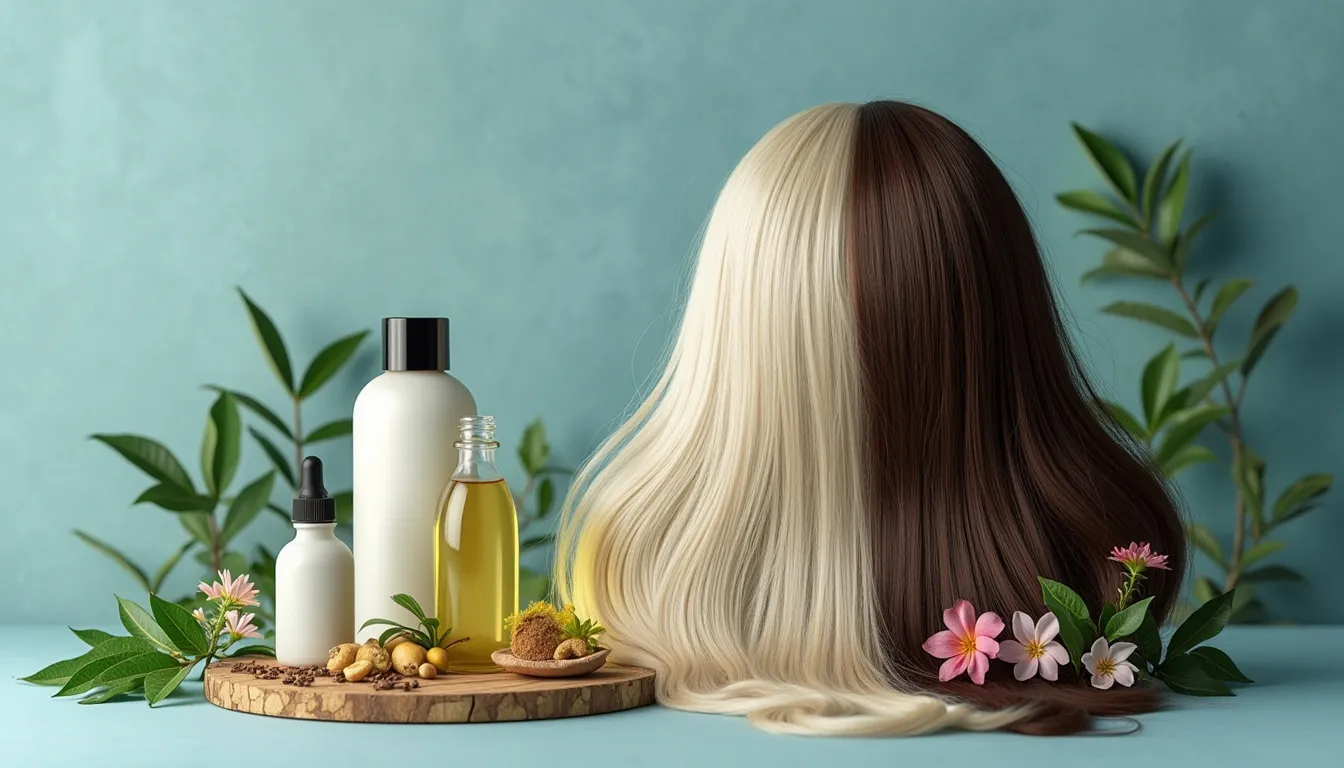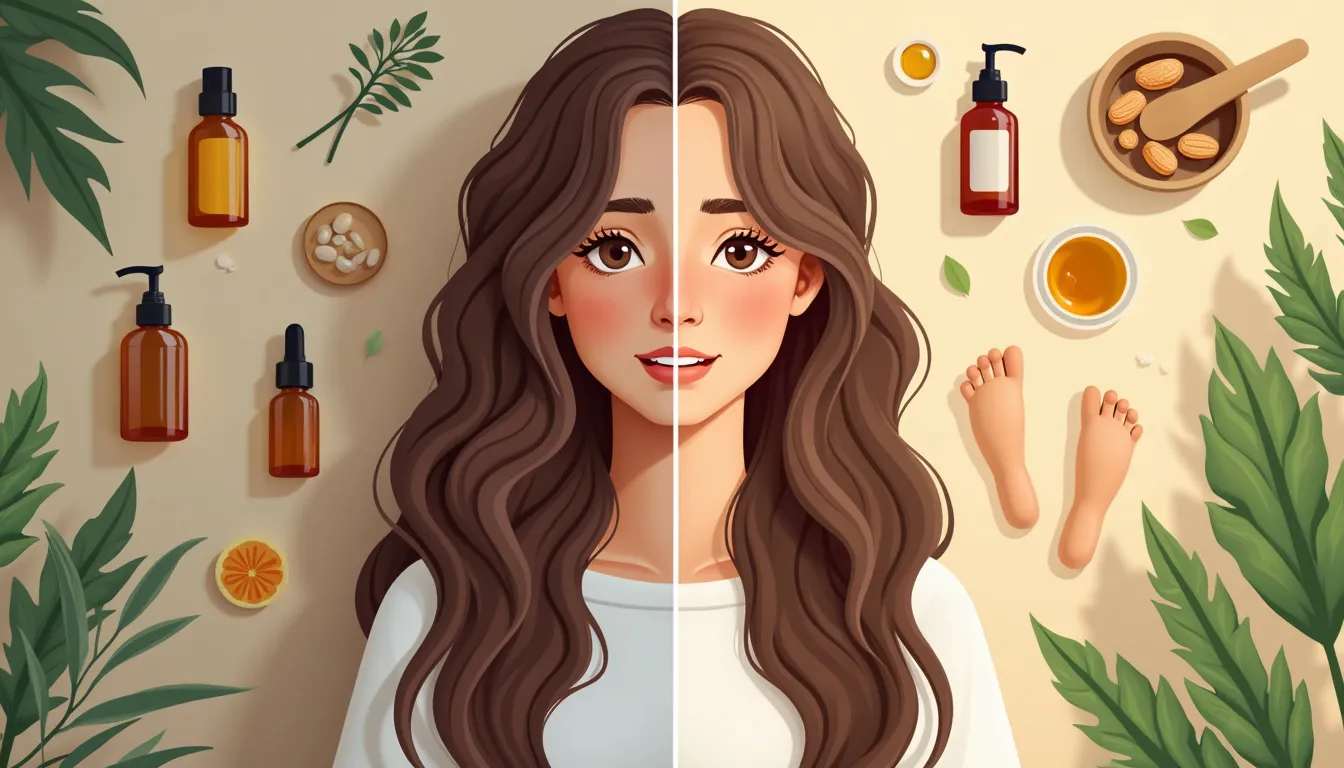Are you noticing more hair in your brush than usual? Don’t panic! Thinning hair is a common concern that affects millions of people worldwide, regardless of age or gender. While it can be distressing, the good news is that there are effective solutions available to combat this issue. In this comprehensive guide, we’ll explore five proven strategies to address thinning hair, helping you regain your confidence and maintain a healthy, vibrant mane. From understanding the root causes of hair thinning to discovering the latest topical treatments and lifestyle changes, we’ve got you covered. Whether you’re just starting to notice some extra shedding or have been struggling with thinning hair for a while, these solutions are designed to work for various stages and types of hair loss. So, grab a cup of tea, settle in, and let’s dive into the world of hair care innovations that could be the game-changer you’ve been searching for. By the end of this article, you’ll be armed with the knowledge and tools to take control of your hair health and say goodbye to thinning locks for good.
Understanding Thinning Hair
Thinning hair is a common concern that affects millions of people worldwide. Whether you’ve noticed more strands in your hairbrush or a widening part, understanding the root causes of hair thinning is crucial for finding effective solutions. Let’s dive into the common causes, how to identify thinning hair, and why early intervention is key.
Common Causes of Hair Thinning
Hair thinning can occur due to various factors, ranging from genetics to lifestyle choices. Here are some of the most prevalent causes:
- Genetics: Androgenetic alopecia, also known as male or female pattern baldness, is the most common cause of thinning hair. It’s linked to your genetic makeup and hormonal changes.
- Hormonal Changes: Fluctuations in hormones, particularly during pregnancy, menopause, or thyroid disorders, can lead to hair thinning.
- Nutritional Deficiencies: Lack of essential nutrients like iron, protein, and vitamins can weaken hair follicles, resulting in thinning.
- Stress: Both physical and emotional stress can trigger a condition called telogen effluvium, causing temporary hair thinning.
- Medications: Certain medications, including some used for cancer, arthritis, depression, and heart problems, can cause hair loss as a side effect.
- Hairstyling Practices: Excessive use of heat styling tools, tight hairstyles, and harsh chemical treatments can damage hair follicles and lead to thinning.
Understanding these causes is the first step in addressing thinning hair effectively. It’s important to note that often, multiple factors contribute to hair thinning, making a comprehensive approach necessary for treatment.
How to Identify Thinning Hair
Recognizing the signs of thinning hair early can make a significant difference in treatment outcomes. Here are some tell-tale signs to watch for:
- Widening Part: If your part appears wider than usual, it could be a sign of thinning hair, especially in women.
- Visible Scalp: More visible scalp, particularly at the crown or temples, can indicate thinning.
- Smaller Ponytail: If you notice your ponytail feeling thinner or requiring more loops of the hair tie, it might be due to hair thinning.
- Excessive Shedding: While it’s normal to lose 50-100 hairs a day, finding more than usual on your pillow or in the shower drain could be a red flag.
- Changes in Texture: Hair becoming finer or more brittle can be an early sign of thinning.
- Receding Hairline: In men, a receding hairline, particularly at the temples, is often the first sign of male pattern baldness.
If you notice any of these signs, it’s advisable to consult with a dermatologist or trichologist for a professional assessment. They can perform tests, including a scalp examination and possibly a biopsy, to determine the cause of your hair thinning.
The Importance of Early Intervention
When it comes to thinning hair, early intervention can make a world of difference. Here’s why acting quickly is crucial:
- Prevent Further Loss: Many hair loss treatments are more effective at maintaining existing hair than regrowing lost hair. The sooner you start treatment, the more hair you can potentially save.
- More Treatment Options: In the early stages of hair thinning, you have a wider range of treatment options available, including less invasive methods.
- Better Results: Early treatment often leads to better outcomes, as hair follicles that have been dormant for too long may not respond to treatment.
- Psychological Benefits: Addressing hair thinning early can help maintain self-confidence and prevent the emotional distress often associated with progressive hair loss.
- Cost-Effective: Treating hair thinning in its early stages can be more cost-effective than trying to reverse advanced hair loss.
One effective early intervention program worth considering is Fortify, which offers a comprehensive approach to combating hair loss. By addressing the issue early, you give yourself the best chance at maintaining a healthy, full head of hair.
It’s important to remember that hair thinning is a common and often treatable condition. With the right approach and early intervention, many people can successfully manage and even reverse hair thinning. Don’t hesitate to seek professional advice if you’re concerned about your hair’s health.
By understanding the causes of thinning hair, knowing how to identify it, and recognizing the importance of early intervention, you’re well-equipped to take the necessary steps to maintain your hair’s health and fullness. Remember, your hair is a reflection of your overall health, so addressing thinning hair often involves improving your general well-being too.

Topical Treatments and Hair Care Solutions
When it comes to combating thinning hair, topical treatments and proper hair care can make a world of difference. These solutions offer a non-invasive approach to addressing hair loss and can be easily incorporated into your daily routine. Let’s explore some of the most effective options available.
Minoxidil and Other Over-the-Counter Options
Minoxidil is perhaps the most well-known topical treatment for thinning hair. This FDA-approved medication has been proven to slow hair loss and even promote regrowth in some cases. Available in both 2% and 5% concentrations, minoxidil works by:
- Increasing blood flow to the hair follicles
- Prolonging the growth phase of the hair cycle
- Enlarging shrunken hair follicles
While minoxidil is effective for many people, it’s important to note that it requires consistent, long-term use to maintain results. Typically, you’ll need to apply it twice daily, and it may take several months to see noticeable improvements.
Other over-the-counter options for thinning hair include:
- Ketoconazole shampoos: These can help reduce inflammation and fight fungal infections that may contribute to hair loss.
- Caffeine-infused products: Some studies suggest that caffeine can stimulate hair growth when applied topically.
- Saw palmetto-based treatments: This natural ingredient may help block DHT, a hormone associated with hair loss.
While these alternatives may not be as extensively studied as minoxidil, many users report positive results. It’s always best to consult with a dermatologist or trichologist before starting any new treatment regimen.
Essential Oils and Natural Remedies
For those preferring a more natural approach to treating thinning hair, essential oils and herbal remedies offer promising alternatives. While scientific evidence may be limited for some of these options, many people swear by their effectiveness. Some popular natural treatments include:
- Rosemary oil: Studies have shown that rosemary oil can be as effective as minoxidil in promoting hair growth.
- Peppermint oil: Known for its cooling effect, peppermint oil may also stimulate blood flow to the scalp.
- Castor oil: Rich in ricinoleic acid, castor oil is believed to improve hair thickness and growth.
- Aloe vera: This soothing plant extract can help reduce scalp inflammation and promote a healthy environment for hair growth.
To use these natural remedies, you can mix a few drops of essential oil with a carrier oil (like coconut or jojoba oil) and massage it into your scalp. Leave it on for at least 30 minutes or overnight before washing it out. Remember to do a patch test first to ensure you don’t have any adverse reactions.
Another popular natural remedy is scalp massage. Regular scalp massages can increase blood flow to the hair follicles, potentially stimulating growth. You can perform these massages with or without oils, using gentle circular motions with your fingertips for 5-10 minutes daily.
Scalp Care and Proper Hair Hygiene
Maintaining a healthy scalp is crucial for preventing and addressing thinning hair. A clean, well-nourished scalp provides the optimal environment for hair growth. Here are some tips for proper scalp care and hair hygiene:
- Choose the right shampoo: Look for gentle, sulfate-free shampoos that won’t strip your hair and scalp of natural oils. If you have a specific scalp condition like dandruff or seborrheic dermatitis, use medicated shampoos as recommended by your dermatologist.
- Don’t overwash: Washing your hair too frequently can lead to a dry, irritated scalp. For most people, washing 2-3 times a week is sufficient. If you have oily hair, you may need to wash more frequently, but try to avoid daily washing if possible.
- Use lukewarm water: Very hot water can damage your hair and irritate your scalp. Stick to lukewarm water when washing your hair.
- Be gentle: Avoid rough towel-drying or aggressive brushing, especially when your hair is wet. Pat your hair dry with a soft towel and use a wide-toothed comb to detangle gently.
- Protect your scalp from the sun: UV rays can damage your scalp and hair follicles. Wear a hat or use hair products with SPF protection when spending time outdoors.
- Avoid tight hairstyles: Ponytails, buns, and braids that pull on your hair can lead to traction alopecia. Opt for looser styles or vary your hairstyle regularly to prevent constant tension on the same areas.
In addition to these practices, consider incorporating a scalp exfoliation routine into your hair care regimen. Scalp exfoliation can help remove dead skin cells and product buildup, promoting a healthier environment for hair growth. You can use a gentle scrub or a silicone scalp massager once a week to exfoliate your scalp gently.
Remember, consistency is key when it comes to hair care. It may take several weeks or even months to see noticeable improvements in your hair’s thickness and overall health. If you’re concerned about persistent thinning hair, it’s always a good idea to consult with a healthcare professional. They can help identify any underlying causes and recommend the most appropriate treatment plan for your specific situation.
For those looking for a comprehensive approach to combat hair loss, programs like Fortify offer tailored solutions that combine various strategies to help stop hair loss and promote healthier, thicker hair. By integrating topical treatments, proper hair care, and lifestyle modifications, you can take a proactive stance against thinning hair and work towards maintaining a fuller, healthier head of hair.

III. Lifestyle Changes and Nutritional Approaches
When it comes to combating thinning hair, making strategic lifestyle changes and adopting a nutrition-focused approach can work wonders. These natural methods not only promote healthier hair growth but also contribute to your overall well-being. Let’s explore some effective strategies to address thinning hair through diet, stress management, and targeted supplementation.
A. Diet Modifications for Healthier Hair
Your diet plays a crucial role in maintaining healthy hair. Nutrient-rich foods can provide the building blocks necessary for strong, vibrant locks. Here are some dietary changes that can help combat thinning hair:
- Protein-rich foods: Hair is primarily made of protein, so consuming adequate amounts is essential. Include lean meats, fish, eggs, and plant-based proteins like beans and lentils in your diet.
- Omega-3 fatty acids: These healthy fats nourish hair follicles and support scalp health. Incorporate salmon, sardines, flaxseeds, and walnuts into your meals.
- Iron-rich foods: Iron deficiency can lead to hair loss. Boost your iron intake with spinach, lean red meat, and fortified cereals.
- Vitamin C: This vitamin aids in iron absorption and collagen production. Citrus fruits, berries, and bell peppers are excellent sources.
- Biotin-rich foods: Biotin, also known as vitamin B7, supports keratin production. Include eggs, nuts, and sweet potatoes in your diet.
Remember, a balanced diet that includes a variety of nutrients is key to promoting overall hair health and addressing thinning hair concerns.
B. Stress Management Techniques
Chronic stress can significantly contribute to hair thinning and loss. Managing stress effectively can help mitigate its impact on your hair. Here are some stress-reduction techniques to consider:
- Meditation and mindfulness: Regular meditation practice can lower cortisol levels, the stress hormone that can contribute to hair loss. Try apps like Headspace or Calm to get started.
- Exercise: Physical activity releases endorphins, which are natural stress-busters. Aim for at least 30 minutes of moderate exercise most days of the week.
- Yoga: Combining physical postures with breathing exercises, yoga can help reduce stress and promote relaxation. Look for beginner-friendly classes or online tutorials.
- Deep breathing exercises: Simple breathing techniques like box breathing or diaphragmatic breathing can quickly lower stress levels.
- Adequate sleep: Poor sleep can exacerbate stress and contribute to hair thinning. Aim for 7-9 hours of quality sleep each night.
Implementing these stress management techniques can not only benefit your hair but also improve your overall quality of life.
C. Supplements and Vitamins for Hair Growth
While a balanced diet should be your primary source of nutrients, supplements can help fill nutritional gaps and support hair growth. Here are some supplements that may be beneficial for addressing thinning hair:
- Biotin: This B-vitamin is often touted for its hair-growth benefits. While more research is needed, many people report positive results with biotin supplementation.
- Vitamin D: Low vitamin D levels have been linked to hair loss. If you’re deficient, supplementation may help. Consider getting your levels checked by a healthcare provider.
- Iron: For those with iron-deficiency anemia, iron supplements can help combat related hair loss. Always consult with a doctor before starting iron supplements.
- Omega-3 fatty acids: Fish oil supplements can provide these essential fatty acids, which support scalp health and may promote hair growth.
- Collagen: As a protein that’s abundant in hair, collagen supplements might support hair structure and growth.
It’s important to note that while supplements can be helpful, they’re not a magic solution for thinning hair. Always consult with a healthcare professional before starting any new supplement regimen, especially if you’re taking other medications.
In addition to these lifestyle changes and nutritional approaches, consider exploring specialized hair loss prevention programs. One such program is Fortify, which offers a comprehensive approach to combating hair loss and promoting healthier, thicker hair.
Remember, addressing thinning hair requires a multi-faceted approach. By combining dietary changes, stress management techniques, and targeted supplementation, you can create an environment that supports healthy hair growth and helps combat thinning hair.
It’s also worth noting that consistency is key when it comes to these lifestyle and nutritional changes. Hair growth cycles can take several months, so be patient and persistent with your efforts. Keep a journal to track your progress and any changes you notice in your hair’s thickness or overall health.
Lastly, while these natural approaches can be highly effective, they work best when combined with proper hair care practices and, if necessary, medical treatments recommended by a dermatologist or trichologist. Don’t hesitate to seek professional advice if you’re concerned about persistent hair thinning or loss.
In conclusion, dealing with thinning hair can be a challenging and emotionally taxing experience. However, armed with the knowledge and solutions presented in this article, you’re now better equipped to tackle this common issue head-on. Remember, the key to success lies in a multifaceted approach that combines topical treatments, lifestyle changes, and proper hair care routines.
By understanding the root causes of thinning hair and identifying the problem early, you can take proactive steps to slow down or even reverse the process. Whether you choose to explore over-the-counter options like minoxidil, embrace natural remedies such as essential oils, or focus on improving your scalp health, there are numerous avenues to pursue in your quest for fuller, healthier hair.
Don’t underestimate the power of lifestyle modifications either. A balanced diet rich in hair-friendly nutrients, effective stress management techniques, and targeted supplements can all contribute significantly to the health and vitality of your locks.
It’s important to note that what works for one person may not work for another, so don’t be discouraged if you don’t see immediate results. Be patient, consistent, and open to trying different combinations of treatments. Consider consulting with a dermatologist or trichologist for personalized advice tailored to your specific situation.
Ultimately, while thinning hair can be distressing, it doesn’t have to define you. With persistence and the right approach, you can take control of your hair health and boost your confidence. Remember, your worth isn’t measured by the thickness of your hair, but by the strength of your character and the fullness of your life.
If you’re looking for an additional resource to help combat hair thinning, consider checking out the Fortify program at hairsecurity.net/fortify. This comprehensive approach might be the extra boost you need in your journey towards healthier, fuller hair.
Stay positive, stay proactive, and here’s to your hair health journey!
